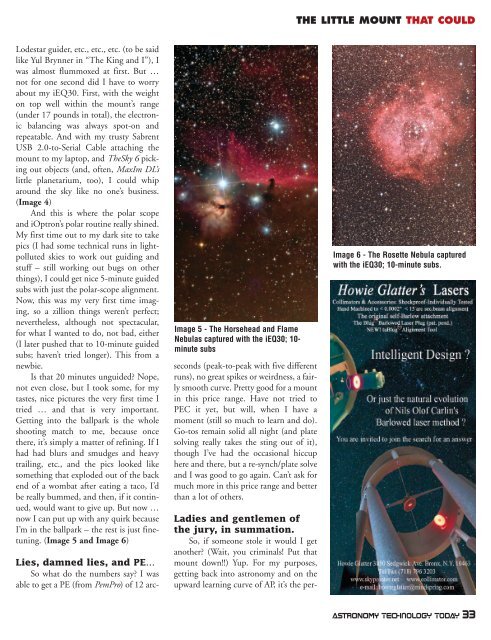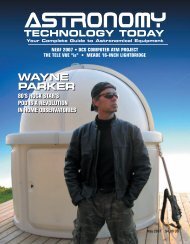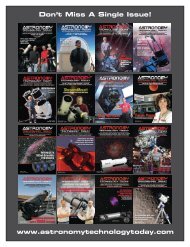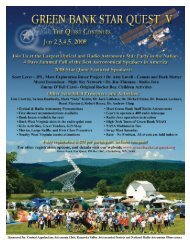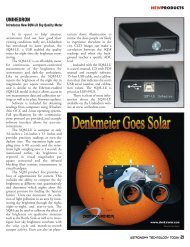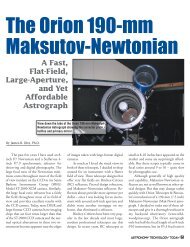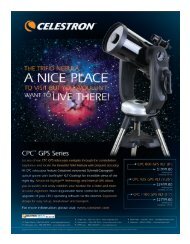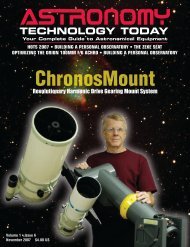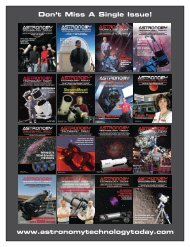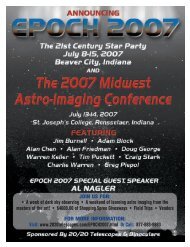iOPTRON - Astronomy Technology Today
iOPTRON - Astronomy Technology Today
iOPTRON - Astronomy Technology Today
You also want an ePaper? Increase the reach of your titles
YUMPU automatically turns print PDFs into web optimized ePapers that Google loves.
THE LITTLE MOUNT THAT COULD<br />
Lodestar guider, etc., etc., etc. (to be said<br />
like Yul Brynner in “The King and I”), I<br />
was almost flummoxed at first. But …<br />
not for one second did I have to worry<br />
about my iEQ30. First, with the weight<br />
on top well within the mount’s range<br />
(under 17 pounds in total), the electronic<br />
balancing was always spot-on and<br />
repeatable. And with my trusty Sabrent<br />
USB 2.0-to-Serial Cable attaching the<br />
mount to my laptop, and TheSky 6 picking<br />
out objects (and, often, MaxIm DL’s<br />
little planetarium, too), I could whip<br />
around the sky like no one’s business.<br />
(Image 4)<br />
And this is where the polar scope<br />
and iOptron’s polar routine really shined.<br />
My first time out to my dark site to take<br />
pics (I had some technical runs in lightpolluted<br />
skies to work out guiding and<br />
stuff – still working out bugs on other<br />
things), I could get nice 5-minute guided<br />
subs with just the polar-scope alignment.<br />
Now, this was my very first time imaging,<br />
so a zillion things weren’t perfect;<br />
nevertheless, although not spectacular,<br />
for what I wanted to do, not bad, either<br />
(I later pushed that to 10-minute guided<br />
subs; haven’t tried longer). This from a<br />
newbie.<br />
Is that 20 minutes unguided? Nope,<br />
not even close, but I took some, for my<br />
tastes, nice pictures the very first time I<br />
tried … and that is very important.<br />
Getting into the ballpark is the whole<br />
shooting match to me, because once<br />
there, it’s simply a matter of refining. If I<br />
had had blurs and smudges and heavy<br />
trailing, etc., and the pics looked like<br />
something that exploded out of the back<br />
end of a wombat after eating a taco, I’d<br />
be really bummed, and then, if it continued,<br />
would want to give up. But now …<br />
now I can put up with any quirk because<br />
I’m in the ballpark – the rest is just finetuning.<br />
(Image 5 and Image 6)<br />
Image 5 - The Horsehead and Flame<br />
Nebulas captured with the iEQ30; 10-<br />
minute subs<br />
Lies, damned lies, and PE…<br />
So what do the numbers say? I was<br />
able to get a PE (from PemPro) of 12 arcseconds<br />
(peak-to-peak with five different<br />
runs), no great spikes or weirdness, a fairly<br />
smooth curve. Pretty good for a mount<br />
in this price range. Have not tried to<br />
PEC it yet, but will, when I have a<br />
moment (still so much to learn and do).<br />
Go-tos remain solid all night (and plate<br />
solving really takes the sting out of it),<br />
though I’ve had the occasional hiccup<br />
here and there, but a re-synch/plate solve<br />
and I was good to go again. Can’t ask for<br />
much more in this price range and better<br />
than a lot of others.<br />
Ladies and gentlemen of<br />
the jury, in summation.<br />
So, if someone stole it would I get<br />
another? (Wait, you criminals! Put that<br />
mount down!!) Yup. For my purposes,<br />
getting back into astronomy and on the<br />
upward learning curve of AP, it’s the per-<br />
Image 6 - The Rosette Nebula captured<br />
with the iEQ30; 10-minute subs.<br />
<strong>Astronomy</strong> TECHNOLOGY TODAY 33


